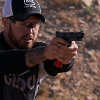If we're talking about felt recoil and not muzzle flip, how the gun fits your hand -- whether it has a narrow or wide grip, the size of the grip. grip angle, and how high you can get your hand on the grip without slide or hammer interference -- can be very important.
Yes. There are a bunch of things that contribute to how shooters
perceive recoil, only some of which involve actual recoil. Blast, flash, flip, area of contact, friction levels, pinch/cut points, bore axis, portion of recoil transmitted to frame during slide movement versus slide-to-frame impact... all of these things have influence on how shooters
perceive recoil, and different people's perceptions will (totally subconsciously) attach different values to each. And that can even change over time! A shooter who first picks up a compensated race gun may perceive it to recoil violently, based on all the blast and flash from the comp... even though video evidence will show it shooting very flat and with moderate recoil. Once they get used to all the fire-and-fury, they will begin to perceive the gun as not recoiling much at all.
This is closely related to the phenomenon of
some people caring a lot about whether a pistol cartridge is "high pressure." Uncorking a barrel at 10k PSI is definitely different in terms of blast than uncorking it at 5k PSI, but if the total momentum of the bullet and ejecta are the same, there should be no or virtually no difference in actual recoil.
I may have mentioned this before, but golf equipment manufacturers spend millions on R&D exploring how the
sound of a club at impact alters the perceived "feel" of the club, even though one can prove as a matter of mathematics and physics that there is no difference in the input that travels to/through the hands and therefore no
actual difference in literally "feel." And different people's brains integrate/synthesize these different sensory inputs into a coherent whole a little bit differently. Perceived recoil is much the same, but the science is not nearly as well developed.





